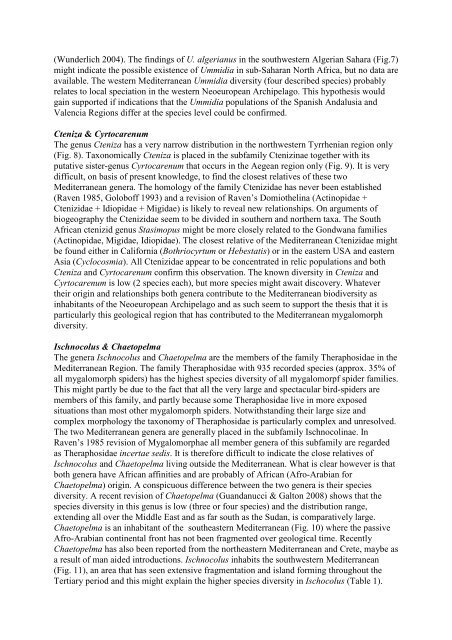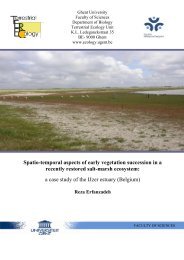PhD Arthur Decae 2010 - Ghent Ecology - Universiteit Gent
PhD Arthur Decae 2010 - Ghent Ecology - Universiteit Gent
PhD Arthur Decae 2010 - Ghent Ecology - Universiteit Gent
Create successful ePaper yourself
Turn your PDF publications into a flip-book with our unique Google optimized e-Paper software.
(Wunderlich 2004). The findings of U. algerianus in the southwestern Algerian Sahara (Fig.7)<br />
might indicate the possible existence of Ummidia in sub-Saharan North Africa, but no data are<br />
available. The western Mediterranean Ummidia diversity (four described species) probably<br />
relates to local speciation in the western Neoeuropean Archipelago. This hypothesis would<br />
gain supported if indications that the Ummidia populations of the Spanish Andalusia and<br />
Valencia Regions differ at the species level could be confirmed.<br />
Cteniza & Cyrtocarenum<br />
The genus Cteniza has a very narrow distribution in the northwestern Tyrrhenian region only<br />
(Fig. 8). Taxonomically Cteniza is placed in the subfamily Ctenizinae together with its<br />
putative sister-genus Cyrtocarenum that occurs in the Aegean region only (Fig. 9). It is very<br />
difficult, on basis of present knowledge, to find the closest relatives of these two<br />
Mediterranean genera. The homology of the family Ctenizidae has never been established<br />
(Raven 1985, Goloboff 1993) and a revision of Raven’s Domiothelina (Actinopidae +<br />
Ctenizidae + Idiopidae + Migidae) is likely to reveal new relationships. On arguments of<br />
biogeography the Ctenizidae seem to be divided in southern and northern taxa. The South<br />
African ctenizid genus Stasimopus might be more closely related to the Gondwana families<br />
(Actinopidae, Migidae, Idiopidae). The closest relative of the Mediterranean Ctenizidae might<br />
be found either in California (Bothriocyrtum or Hebestatis) or in the eastern USA and eastern<br />
Asia (Cyclocosmia). All Ctenizidae appear to be concentrated in relic populations and both<br />
Cteniza and Cyrtocarenum confirm this observation. The known diversity in Cteniza and<br />
Cyrtocarenum is low (2 species each), but more species might await discovery. Whatever<br />
their origin and relationships both genera contribute to the Mediterranean biodiversity as<br />
inhabitants of the Neoeuropean Archipelago and as such seem to support the thesis that it is<br />
particularly this geological region that has contributed to the Mediterranean mygalomorph<br />
diversity.<br />
Ischnocolus & Chaetopelma<br />
The genera Ischnocolus and Chaetopelma are the members of the family Theraphosidae in the<br />
Mediterranean Region. The family Theraphosidae with 935 recorded species (approx. 35% of<br />
all mygalomorph spiders) has the highest species diversity of all mygalomorpf spider families.<br />
This might partly be due to the fact that all the very large and spectacular bird-spiders are<br />
members of this family, and partly because some Theraphosidae live in more exposed<br />
situations than most other mygalomorph spiders. Notwithstanding their large size and<br />
complex morphology the taxonomy of Theraphosidae is particularly complex and unresolved.<br />
The two Mediterranean genera are generally placed in the subfamily Ischnocolinae. In<br />
Raven’s 1985 revision of Mygalomorphae all member genera of this subfamily are regarded<br />
as Theraphosidae incertae sedis. It is therefore difficult to indicate the close relatives of<br />
Ischnocolus and Chaetopelma living outside the Mediterranean. What is clear however is that<br />
both genera have African affinities and are probably of African (Afro-Arabian for<br />
Chaetopelma) origin. A conspicuous difference between the two genera is their species<br />
diversity. A recent revision of Chaetopelma (Guandanucci & Galton 2008) shows that the<br />
species diversity in this genus is low (three or four species) and the distribution range,<br />
extending all over the Middle East and as far south as the Sudan, is comparatively large.<br />
Chaetopelma is an inhabitant of the southeastern Mediterranean (Fig. 10) where the passive<br />
Afro-Arabian continental front has not been fragmented over geological time. Recently<br />
Chaetopelma has also been reported from the northeastern Mediterranean and Crete, maybe as<br />
a result of man aided introductions. Ischnocolus inhabits the southwestern Mediterranean<br />
(Fig. 11), an area that has seen extensive fragmentation and island forming throughout the<br />
Tertiary period and this might explain the higher species diversity in Ischocolus (Table 1).










